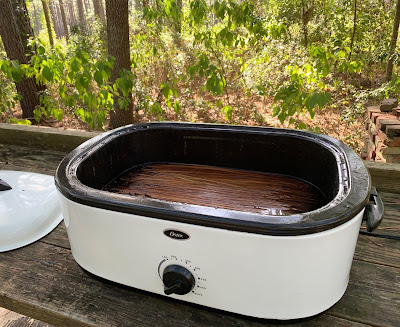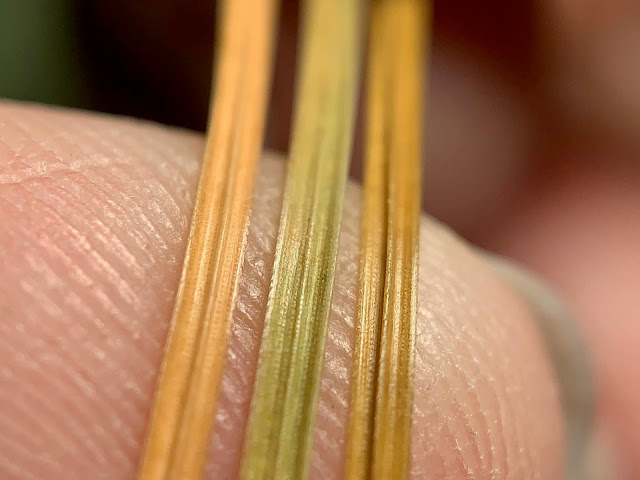One problem with picking up pine straw one at a time by hand is chiggers. I have several chigger bites right now and I haven't been in the woods at all. All I've done is pick up pine straw from my lawn. I'd be mortified if somebody got a chigger bite from a package I sent them. So I boil the pine straw in a concoction containing glycerin. Then I leave it in there overnight to cool off. Then I rinse the needles well and dry them in the sun. Repeat.
 |
| Boil it up |
- The rough feeling edges are a badass row of spines angled toward the very sharp pointy tip.
- Three needle bundles are a neat triangular packing scenario. But four comes out as an overlapping pinwheel arrangement. The 2 needle one has cup shaped needles and a hole up the middle
- Longleaf pine needles are a helix and the number of needles = the number of turns
- The 4 needle pine straws are heavier per unit length than the 3 needle ones. Comparing individual needles I mean. It's not just that there's an extra one
Questions that remain unanswered:
- What happens that makes some pine straws have a different number of needles? Is it a recessive gene?
- What makes the gene expression happen? Chaos?
- Is it the same thing as three leaf clovers having 4 leaves sometimes?
- How come the number of turns in the helix equals the number of needles in the bundle? This is not a Fibonacci sequence. It's something else. Nothing I could find about helix math addresses this inside shape business.
- Why did I only find one paper with a cross section image of a pine needle? And it was from New Zealand. Come on!
Here are some images from my toy USB microscope
 |
| Sharp tip of a 3 needle pine straw, 10x |
 |
| Spinose margin of a 3 needle pine straw, 60x |
 |
| Cup shaped back side of a needle from a 2 needle pine straw, 10x |
 |
| Trying-to-be-a-triangle back side of a 3 needle pine straw, 10x |
 |
| Giant ridge on the back of a needle from a 4 needle pine straw, 10x |
Here's some cross section images taken with my phone with a Moment Macro lens
 |
| Sections sliced with a razor blade in a drop of water |
 |
| Sections through the fascicle, held together with thread and hot glue. |
The helical design of the n=2 pine needles I looked at came out with decreasing pitch with the increase in number of needles.
2 needle straw, 9 1/2" long/2 turns = 4.75" pitch
3 needle straw, 10" long/3 turns = 3.33" pitch
4 needle straw, 12" long/4 turns = 3" pitch
I could examine n=15+ of 3 needles pine straws and see if pitch is consistent or if number of turns is consistent over various lengths. I'm guessing the number of turns is the same and pitch will vary with the length of the needle. But it was obvious just looking at them that the 4 needle straw is a higher pitch helix. A lot of needles I pick up seem to be more twisted though. I should see if I can tell what is different about them. I usually don't keep those as the flatter ones are nicer for coiling into a basket.
Finally I was curious about the mass per length. The 4 needle straws just feel chunkier.
I picked up a few hundred 3 needle pine straws and ignored thousands more. I mostly pick them up by color. I go for the brightest yellow ones because they're the freshest. UV darkens them after the chlorophyll goes away.
12" of pine needle: 4" x 3 of a three needle straw = 0.14 g
vs 3" x 4 of a four needle straw = 0.16 g
(Sorry for using inches instead of cm. I measured off this cutting mat marked in inches. 12" = 30.48 cm)
 |
| 3 needle straw = 0.0046 g/cm |
 |
| 4 needle straw = 0.0052 g/cm |
This is rather meaningless with a scale only precise to 0.05 grams, but I just felt like the 4 needle straw was so much beefier I wanted to know if it was the individual needles or if it was an illusion because there was one extra.
I drew my observations so I could remember what I learned. If I find more of these aberrant pine straws I'll increase n.
**UPDATE 13 October 2019 **
I found more 2 and 4 needle pine straws today. My hypothesis about the number of needles = number of twists would appear to be false.
 |
| A days collection of 2 and 4 needle pine needles |
I have a new hypothesis about the twists. I saved 2 regular 3 needle pine straws to examine closely. One had almost no twist at all. It also had 3 distinctly different colors of needles so it was easy to verify it didn't twist. The underside of the needles seemed very symmetrical.
 |
| Needles with hardly any twist. Very symmetrical. |
 |
| Trying to capture the height of the middle ridge |
I also saved a super twisty one. This one is so twisty the needles tangle up and require careful separation.
 |
| I didn't take a photo like this of the other bundle because there was nothing to see. It was just straight.This one twists hard. |
 |
| This pine straw is so twisty it was hard for me to get the needles all flat for a photo |
 |
| I had to do them one at a time. See how the center rib is offset? I bet that's why it twists like crazy. You can count the rows of stomata. There are more on the left side than on the right. |
I wonder if I had a good method for sealing these in their original shape and taking a cross section and a good microscope could I identify some structural component inside that would reveal the symmetry or lack of it in each bundle? I'm not sure it matters. Just basic knowledge I guess. Would be nice to know what is normal in case climate change makes something wacky happen.
Meanwhile I'll keep stockpiling these wrong-number pine straws as I find them in case I get enough to actually constitute a statistically valid assessment. I should note I am not finding these all under the same tree. I found the two 2 needles straws on my actual front steps. The 4 needle straws I found today were in the shade on the North side of the shed. The other 2 needle straws came from over by the well. The 4 needle straws I found the day before were West of the shed and right by the steps to the lab.




